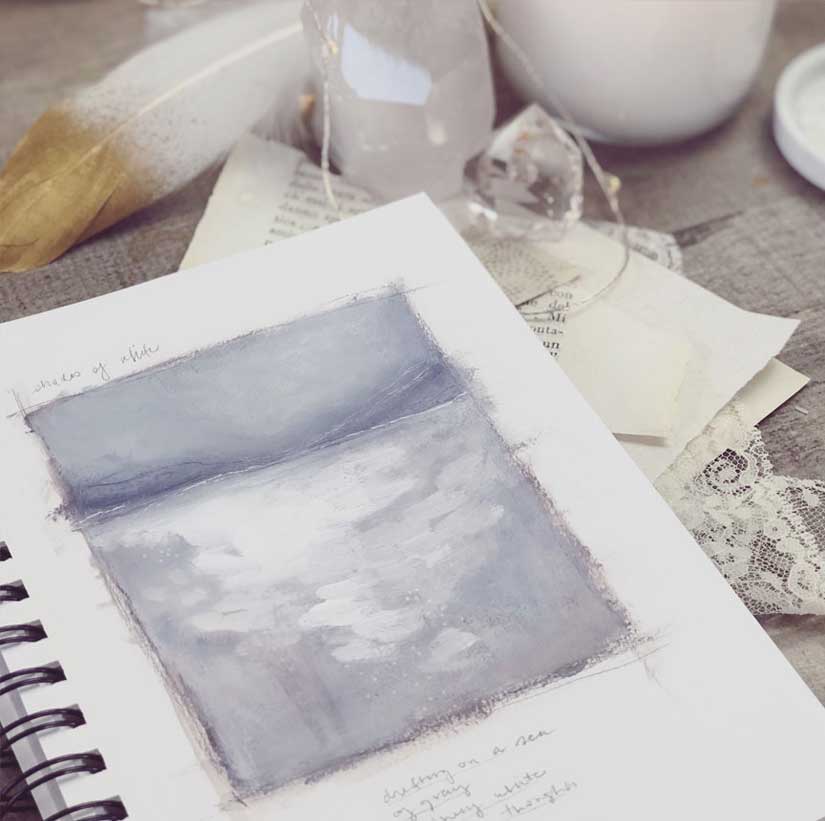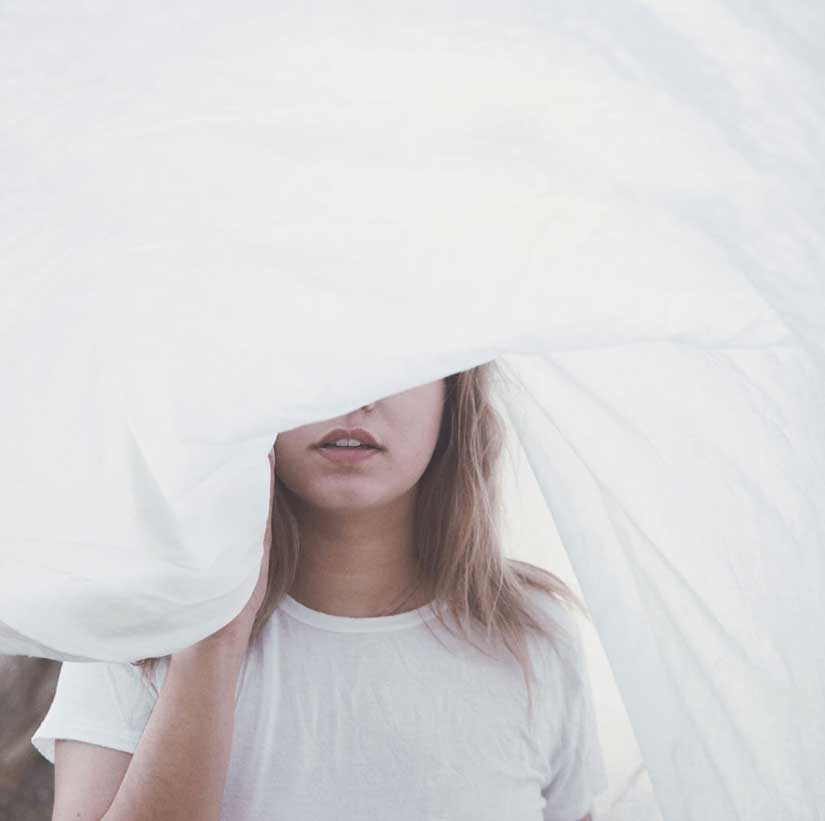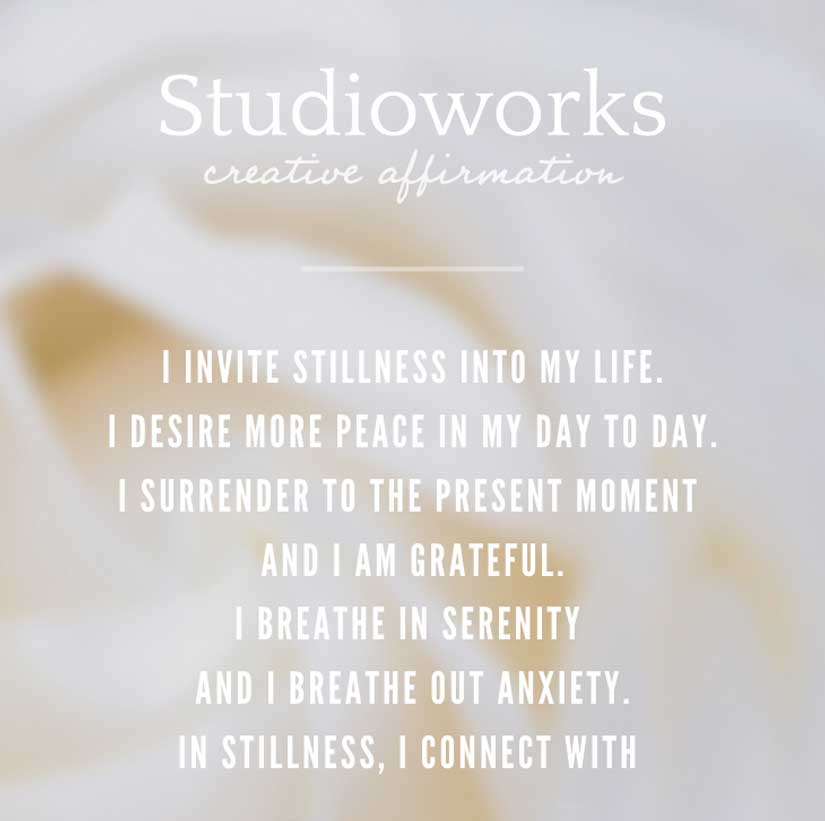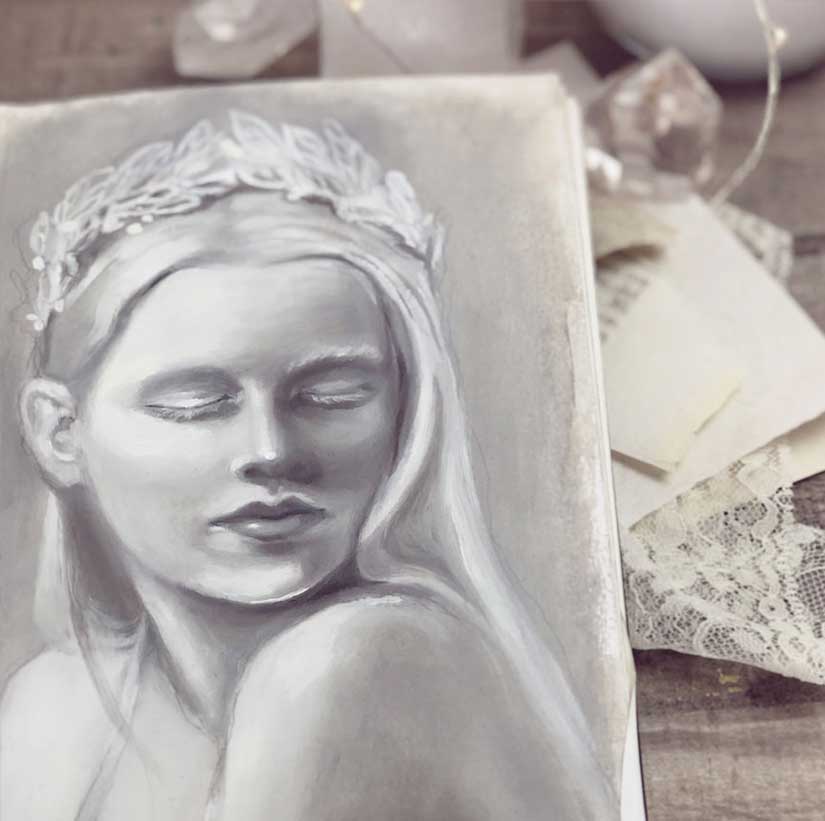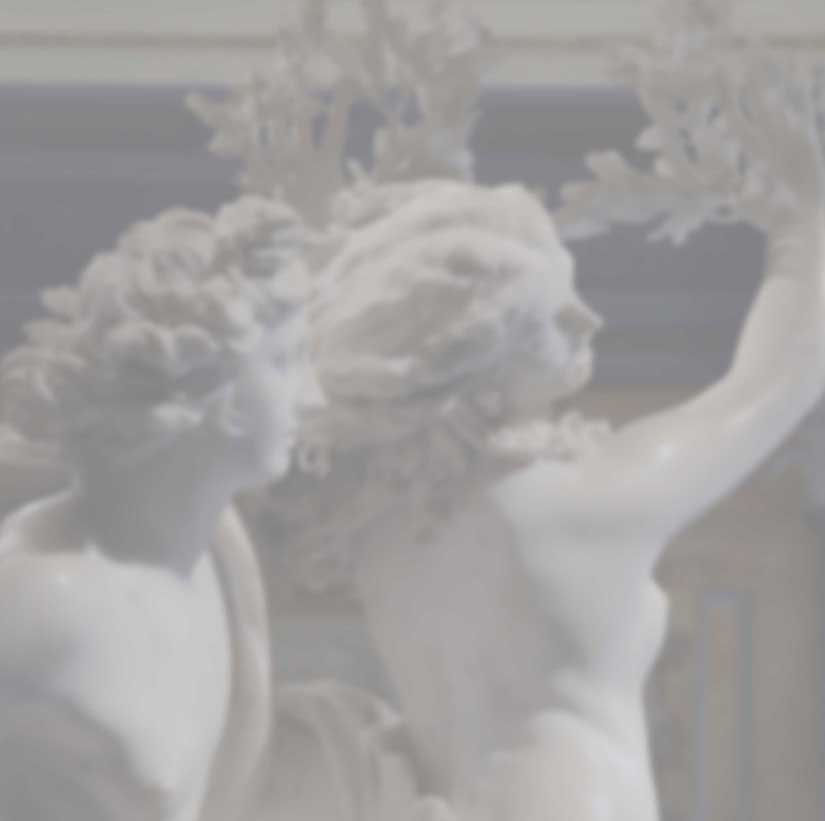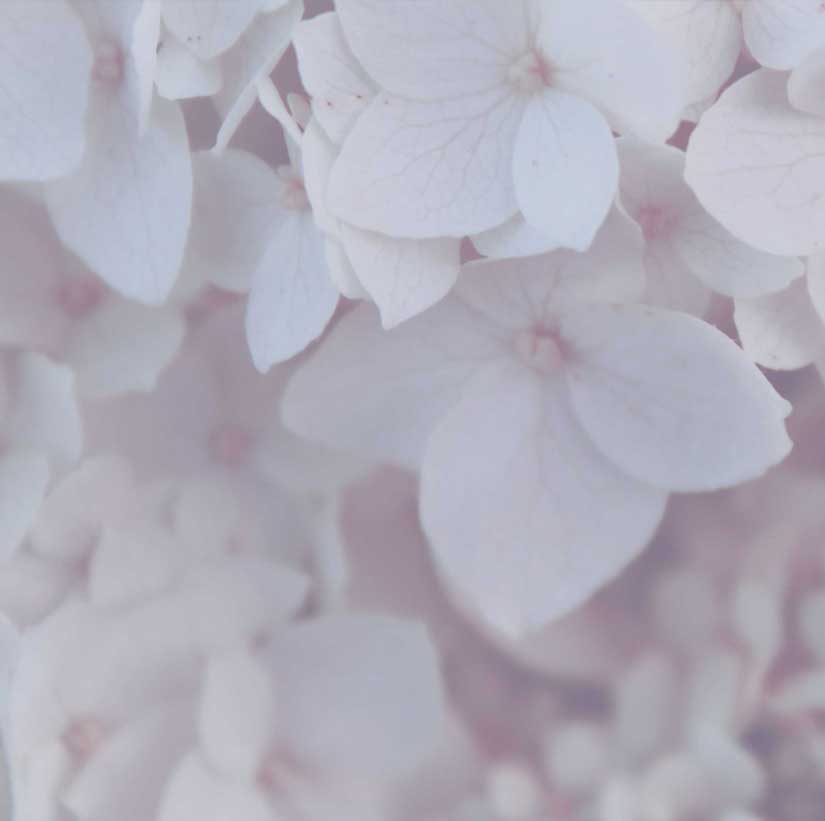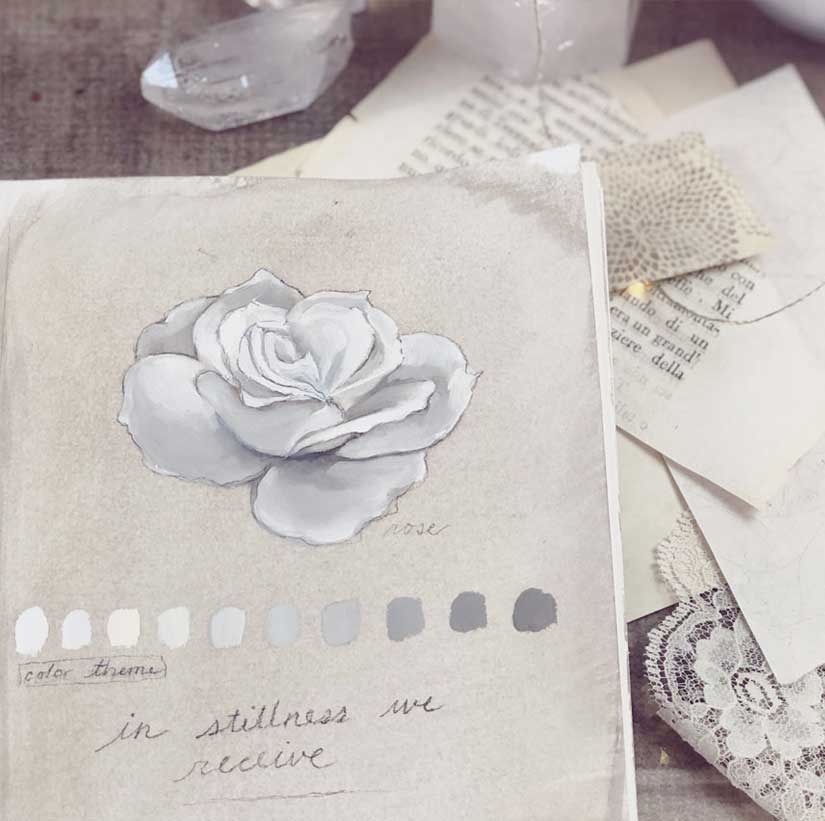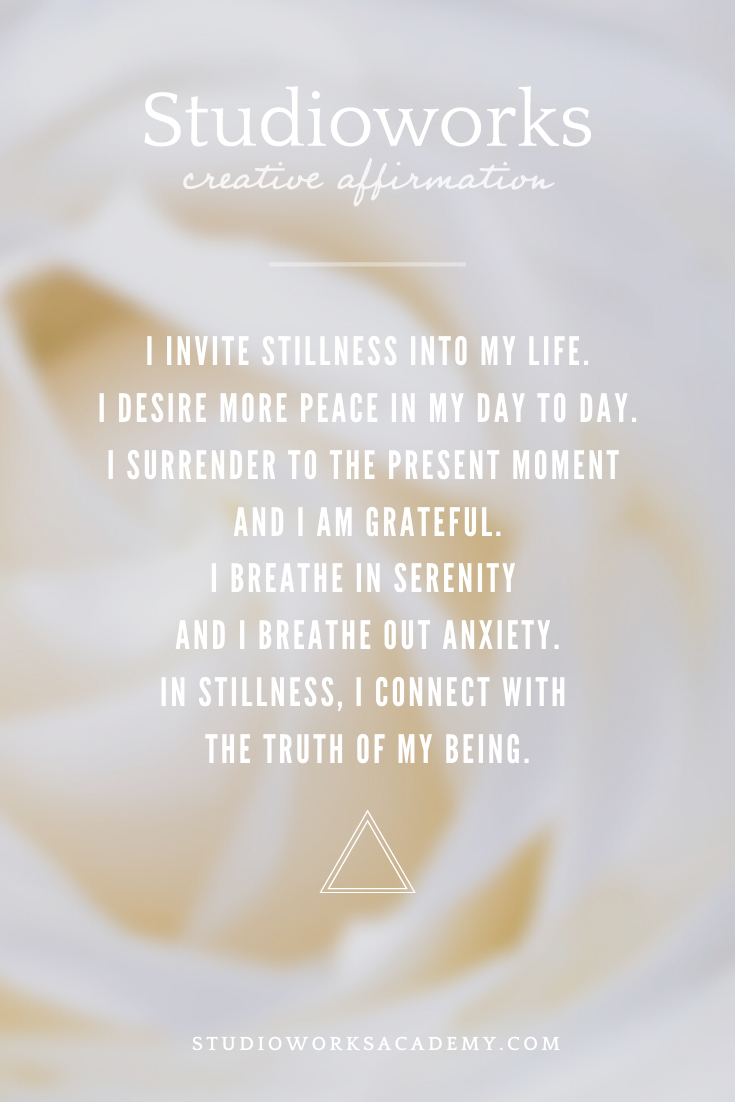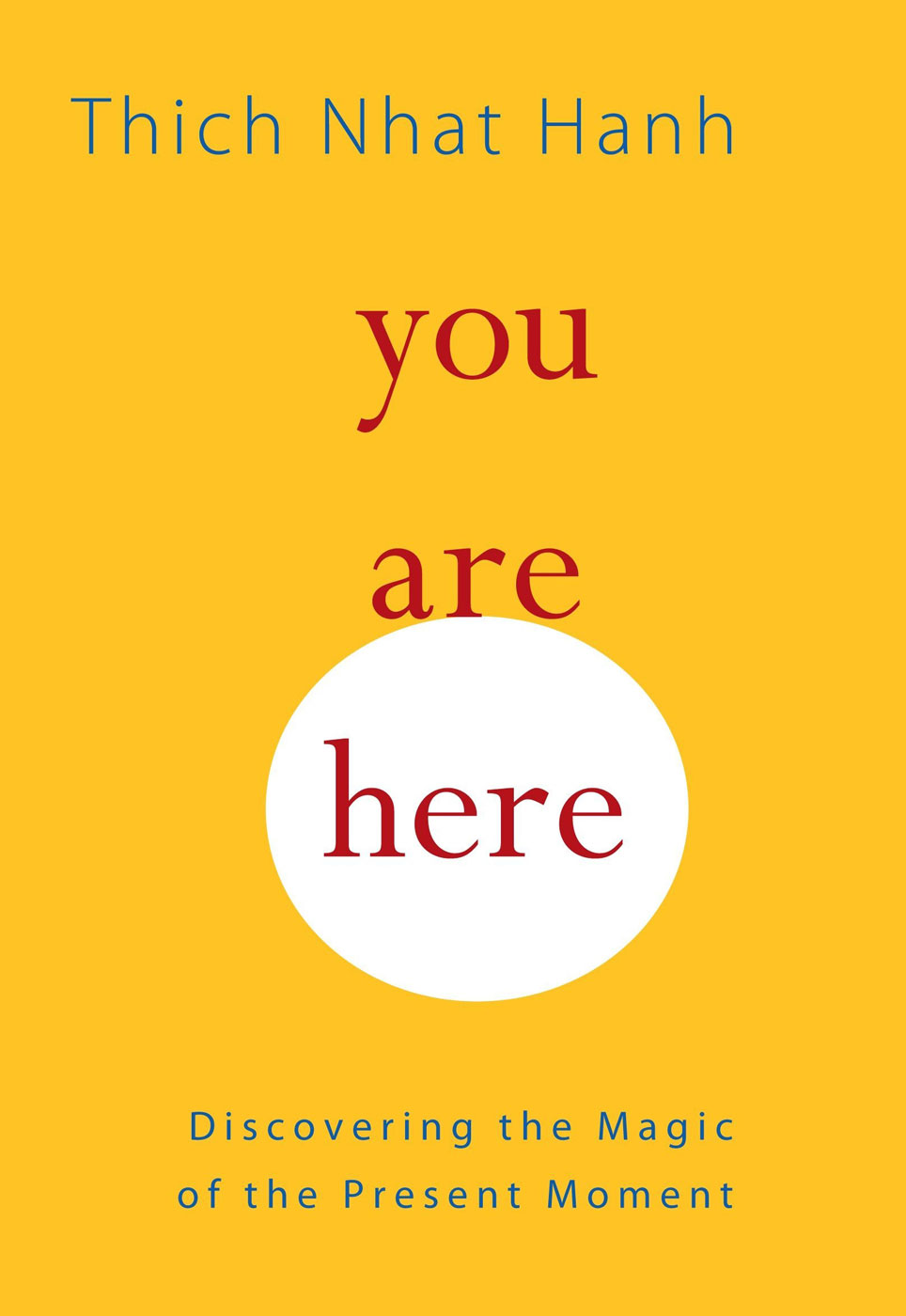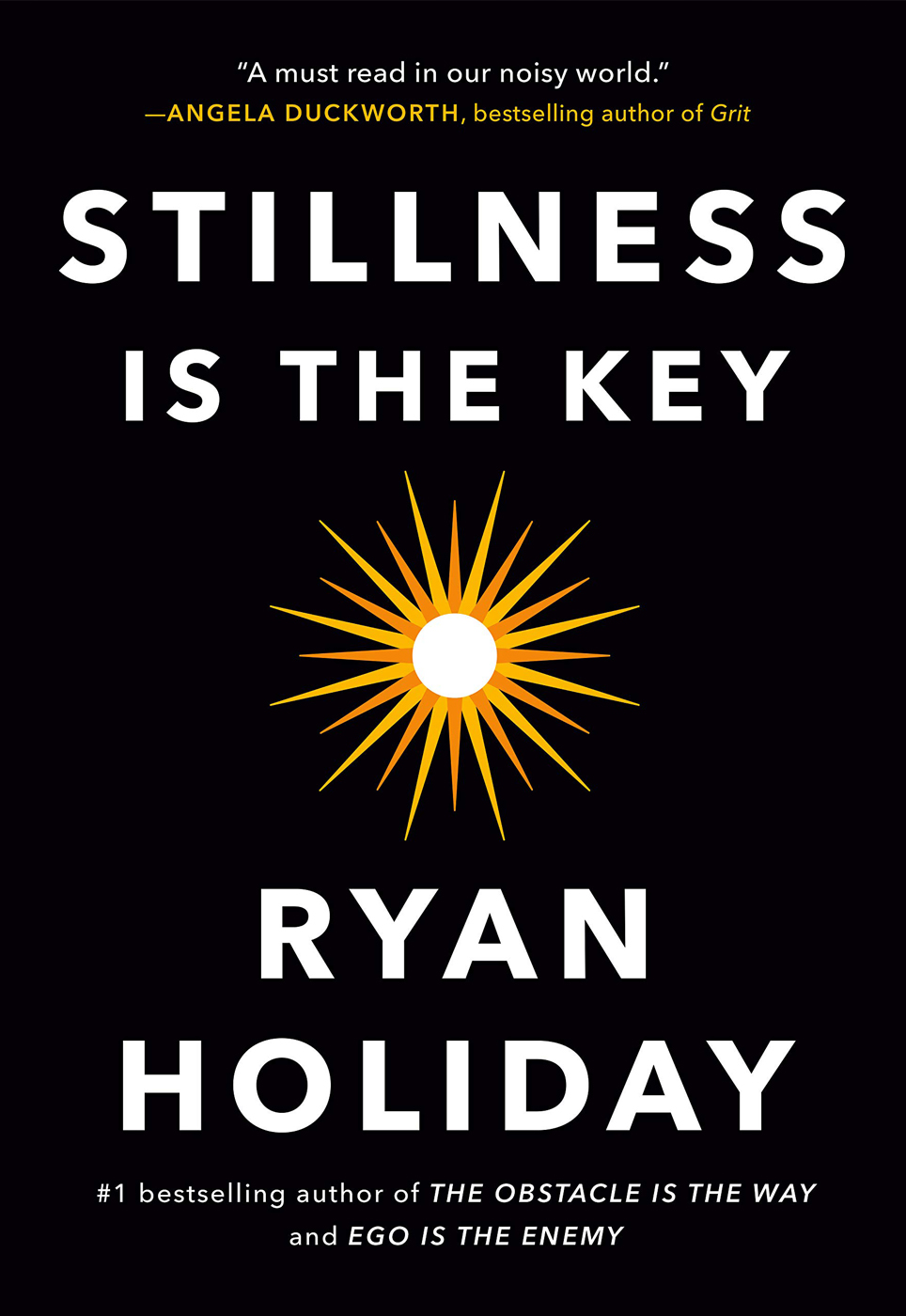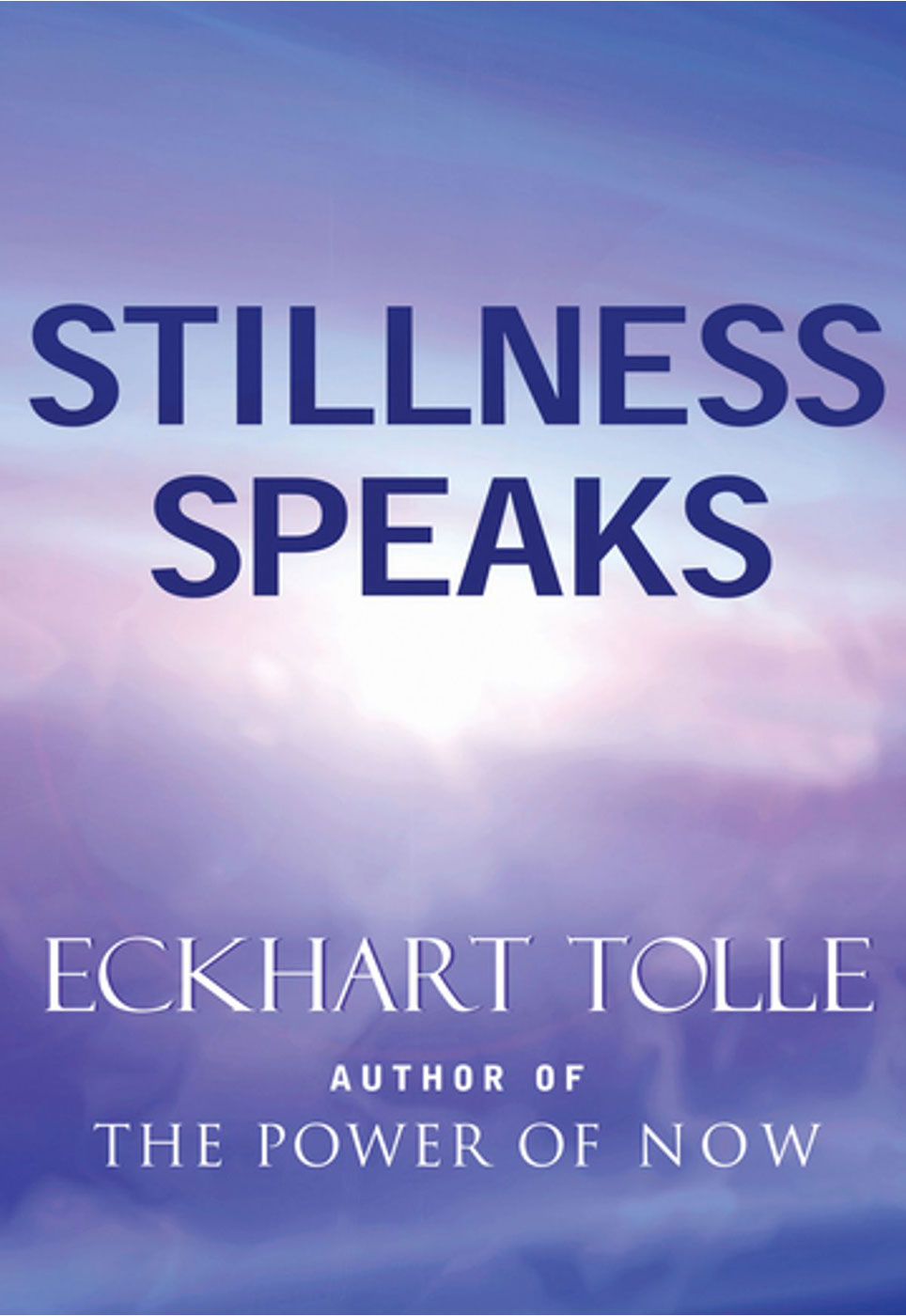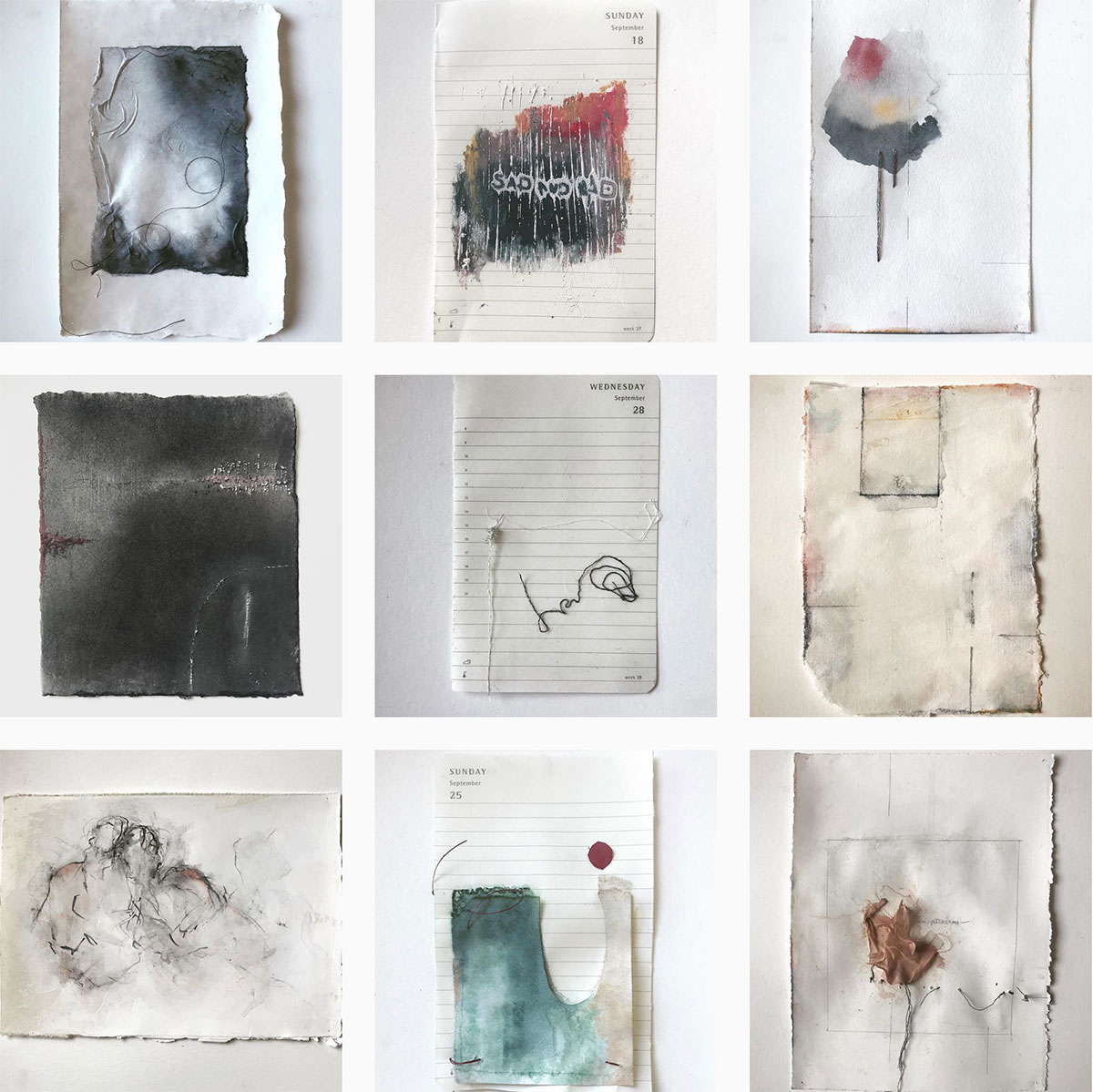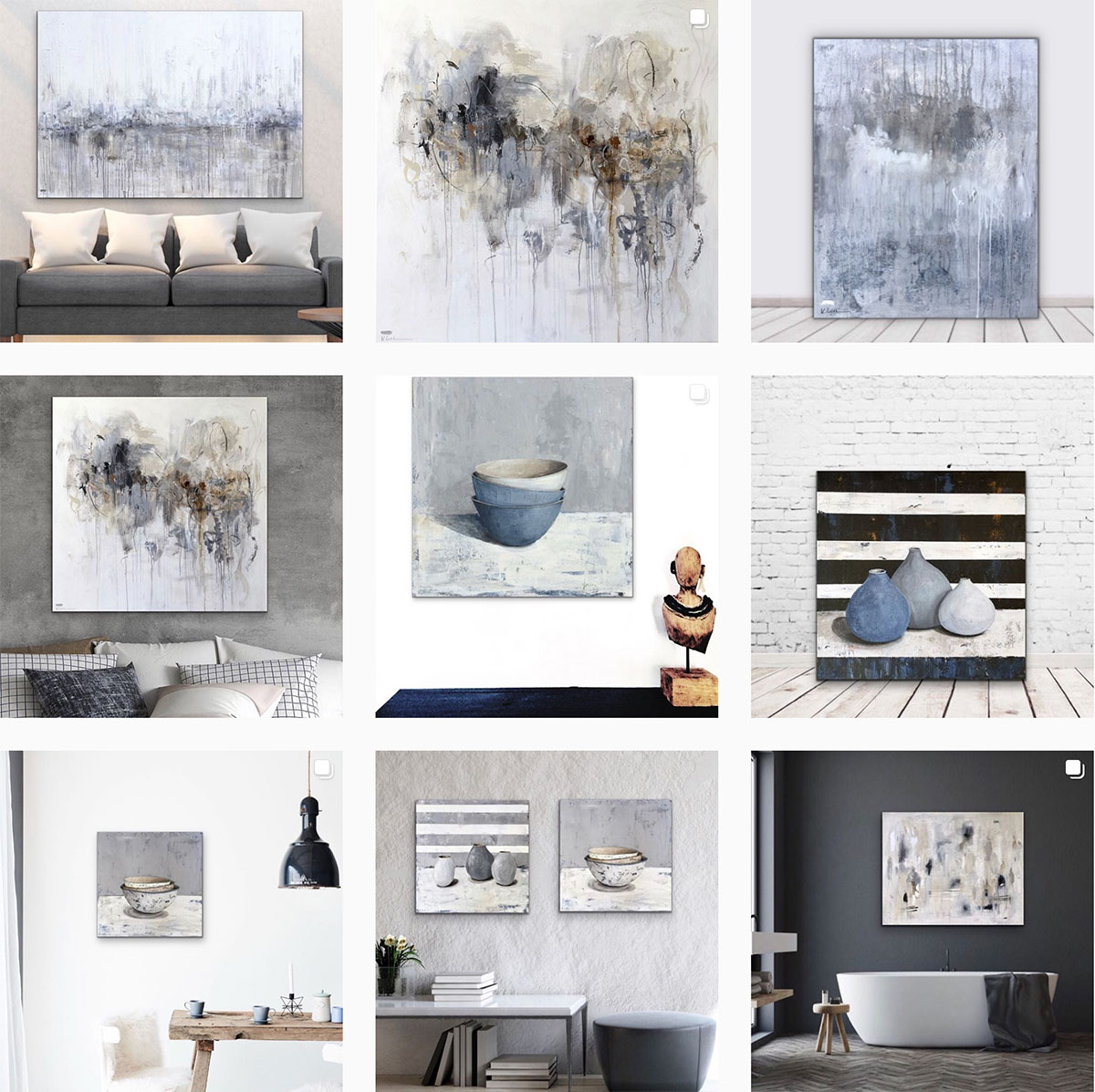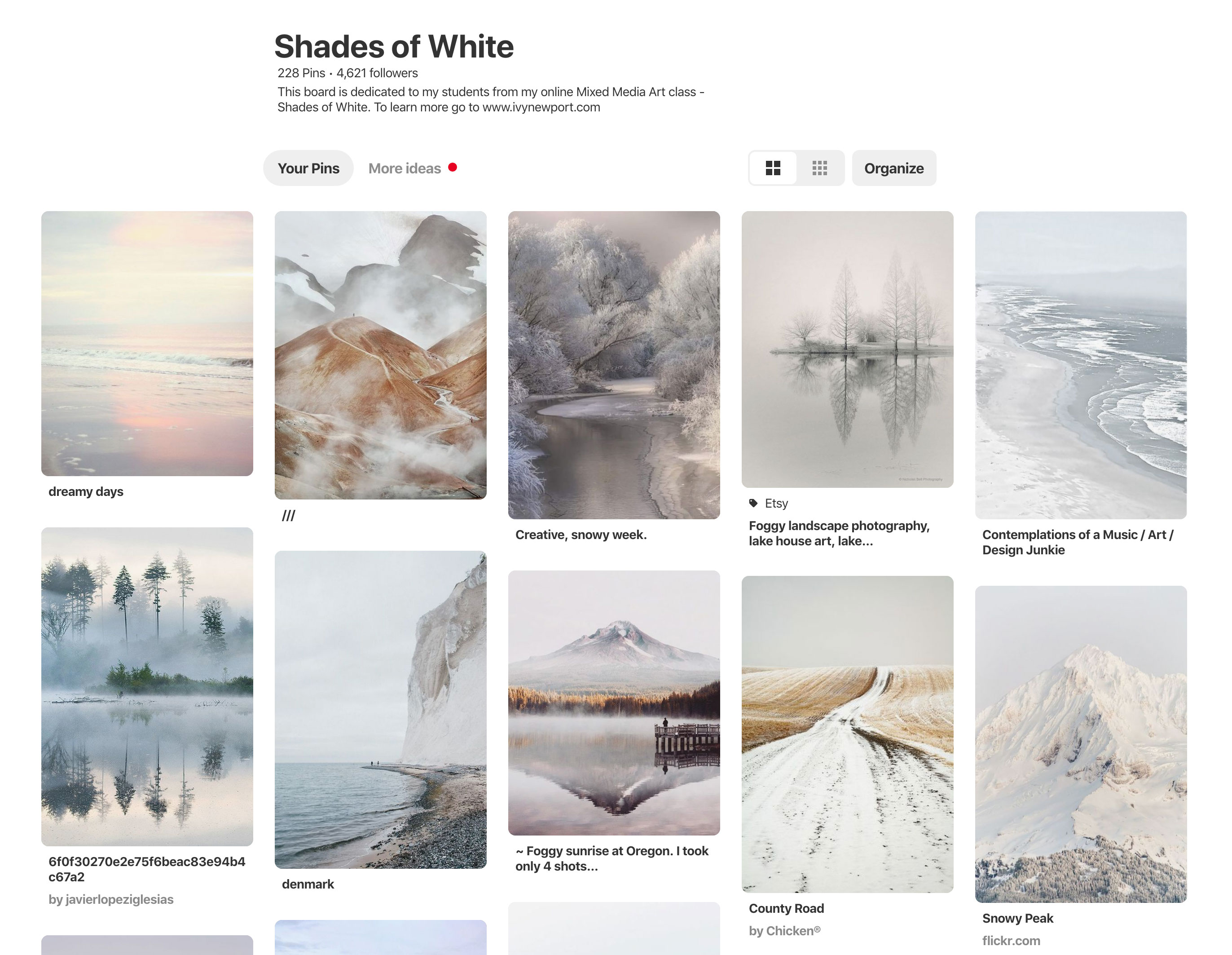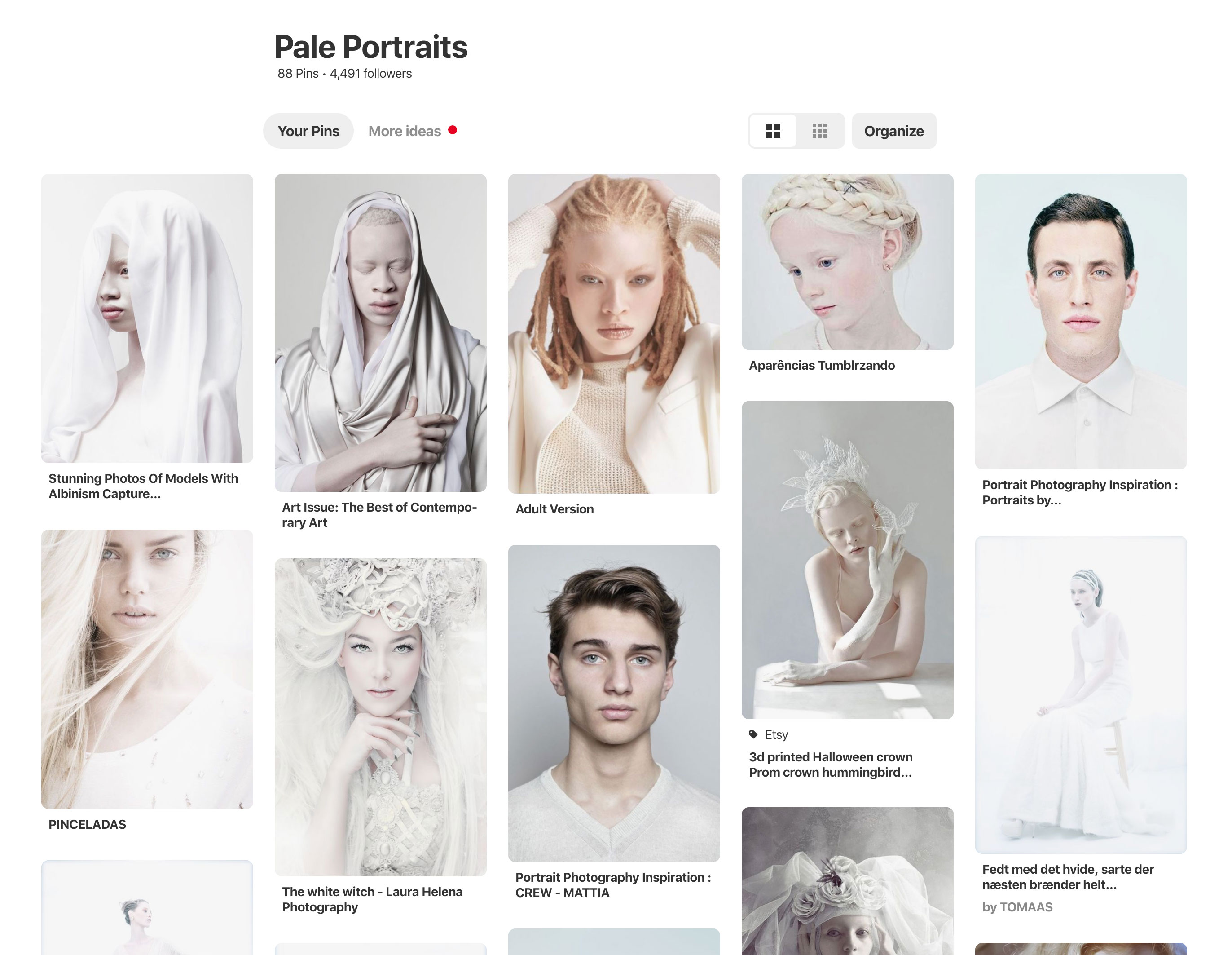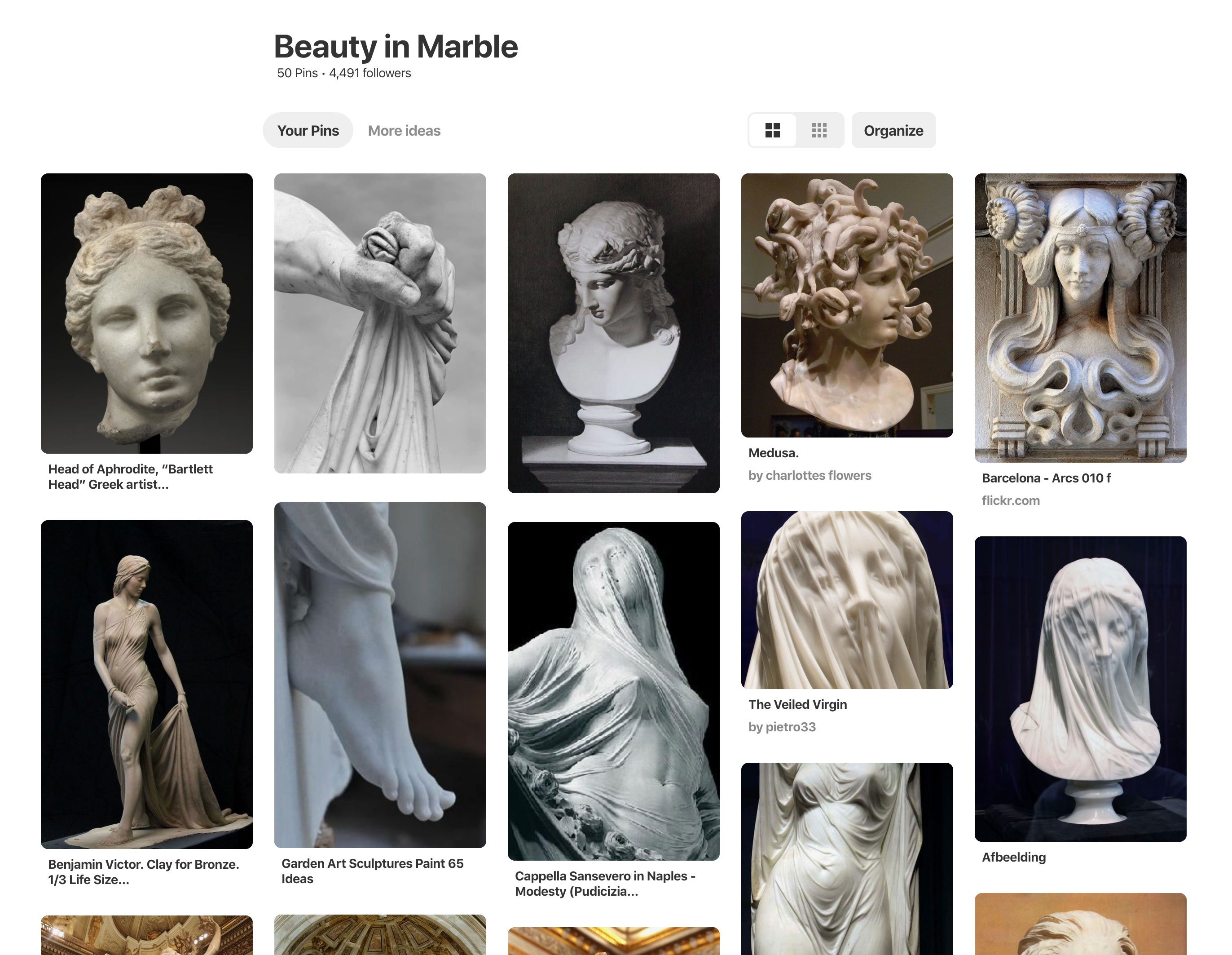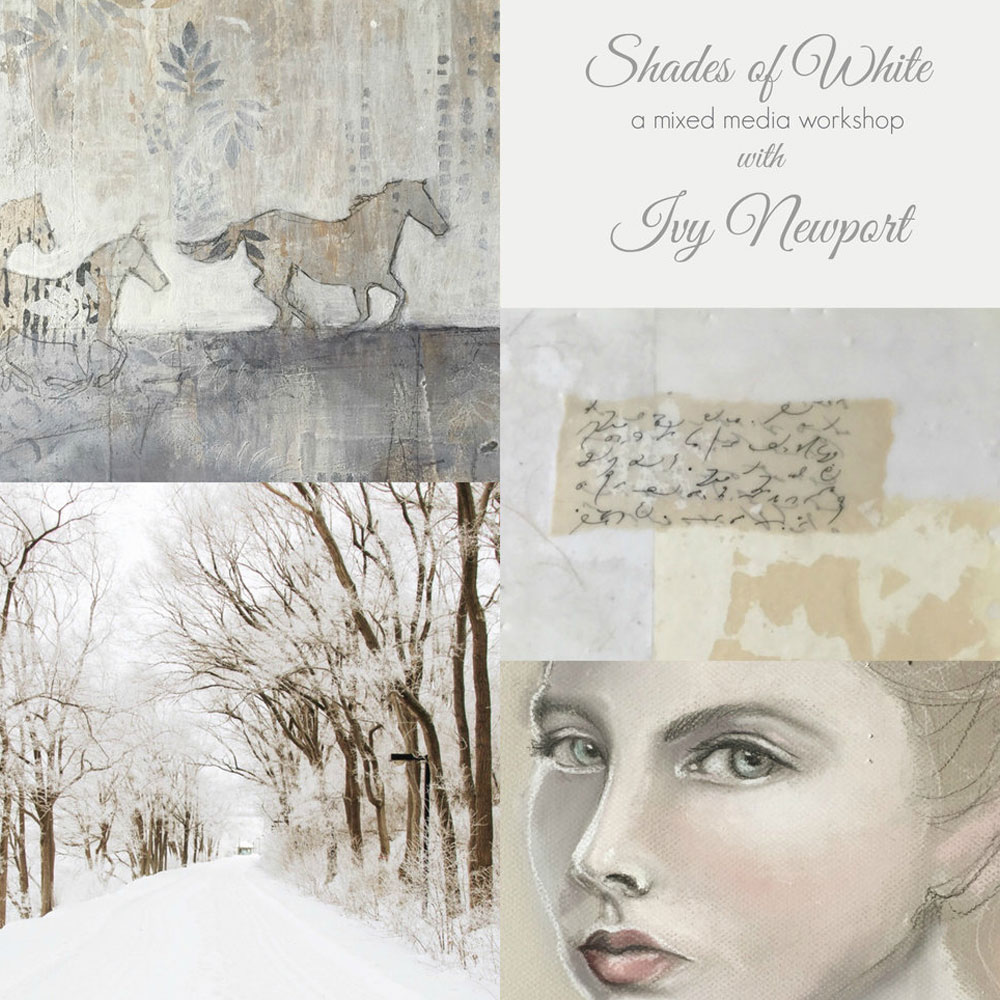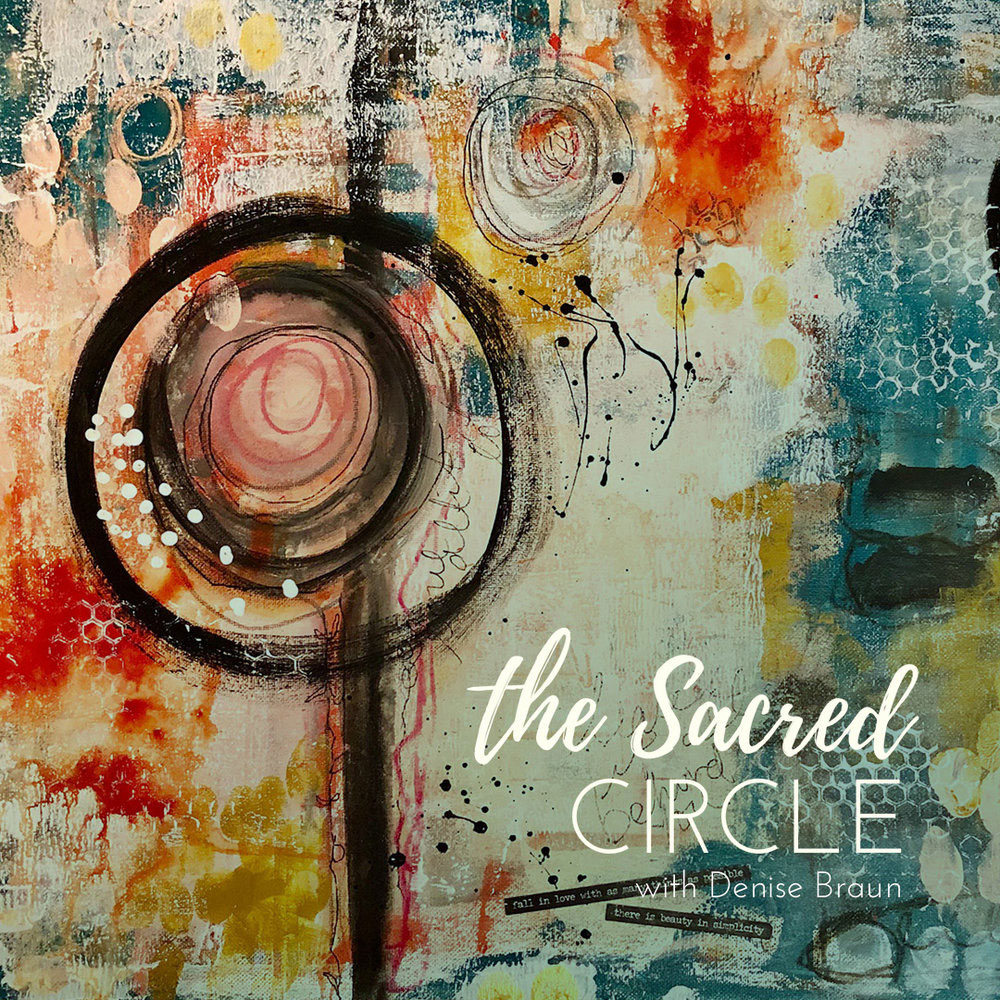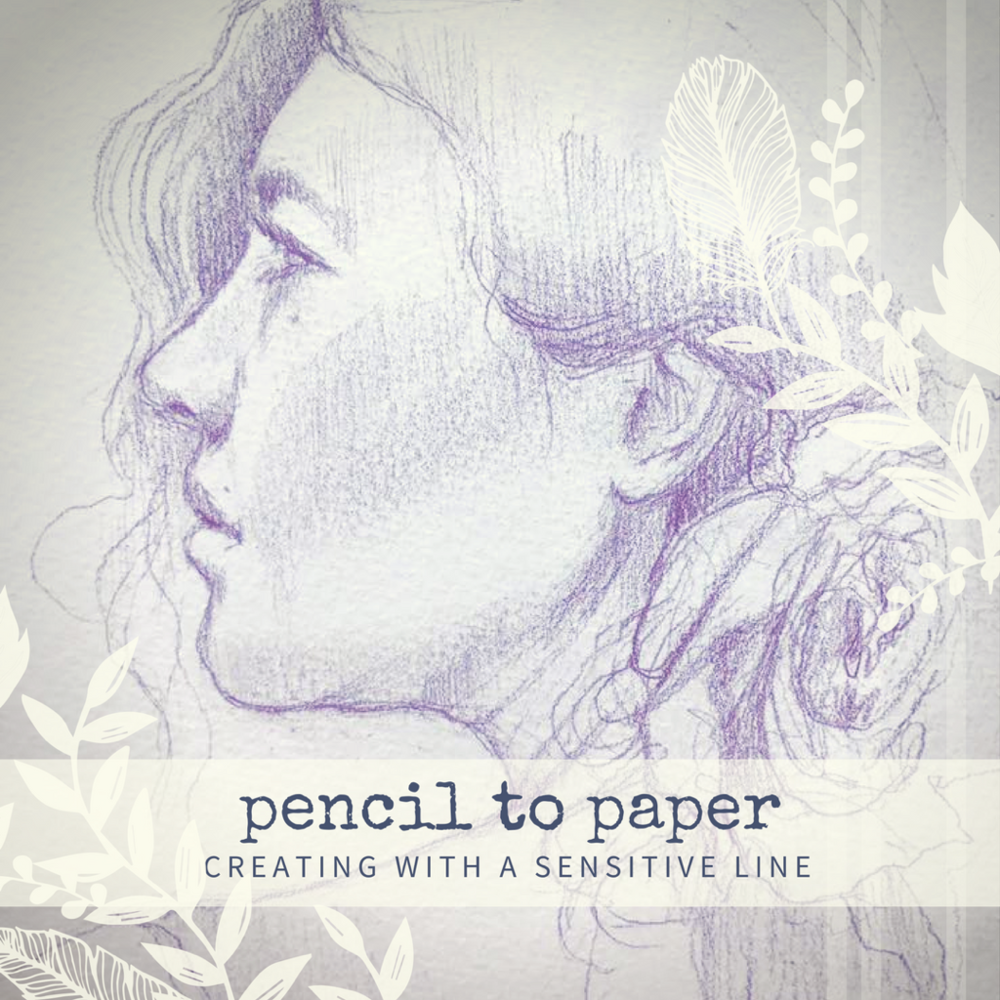IVY NEWPORT
Studioworks
Journal
a letter from ivy
Dear creative friends,
Welcome to Issue #11 of the StudioWorks Journal! As always, I’m super grateful you are here with me and I’m excited to share this with you. I hope you enjoyed reveling in beauty last month.
This time, I am taking us on a journey into stillness. We will explore the importance and sacred gift of becoming still, getting centered and accessing the infinite creativity that dwells within us all.
So take a deep, slow breath, let your shoulders relax and join me.
xo,

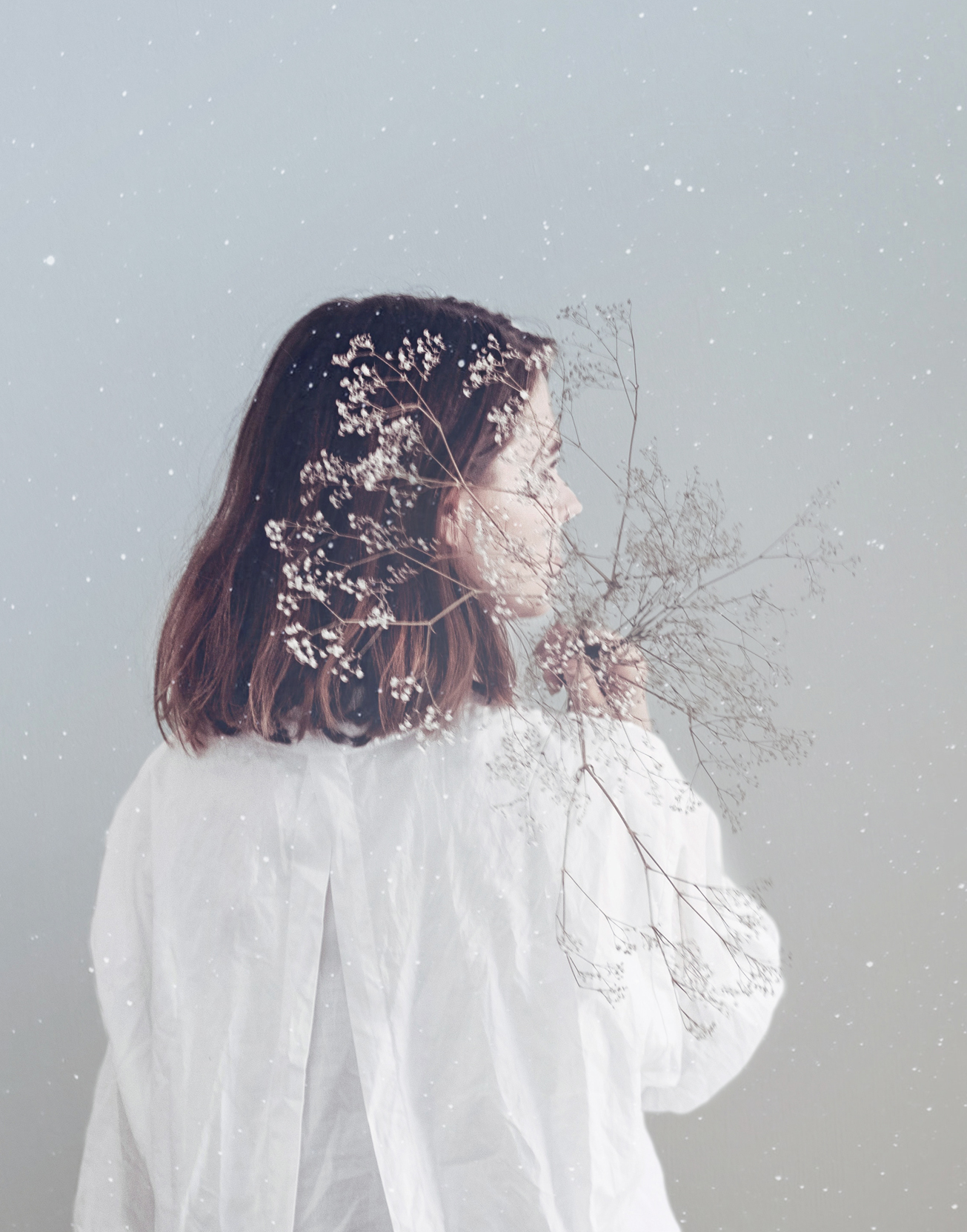
So you may be wondering, where do I start? To that, I say, wherever feels right to you. Each month we will have a theme, a creative affirmation, a power word, a color palette, sketchbook exercises, art projects, articles, recommended reading and access to wonderful inspiration and resources. I want you to think of this as a delicious new magazine, you know the ones you occasionally splurge on, with soft, velvety pages, beautiful images
Each issue will invite you to explore your creative practice in whichever way works for you. Experience each issue at your own pace. Take what resonates with you and put the rest aside for another time.
Grab a cup of something lovely and dive in.
MONTHLY THEME
Stillness
The Sacred Gift of Stillness
I have to confess, befriending stillness has been a challenge. In a swirling, busy, distracted world, I often feel like a leaf blowing in the wind. Bouncing from one activity to the next. One obligation after another. Clean this, fix this, check on that, drive there, read that, create this. I know you can all relate.
However, my soul, now more than ever, has been yearning to slow down. To stop and witness all the chaos, to remove myself from the frenetic equation. But how? I have responsibilities and family members and friends and pets and work…all these things need my attention!
Well, I have found that through writing this journal, my spirit is ready to try something new – becoming still. Becoming quiet, sitting down and closing my eyes. Yes! – In the midst of all the noise. My ego fights this every time, just like it fights me when I go to create! Ahh… that’s how I know I’m on the right track! When our egos or inner critics start to whine, you are approaching new territory. The edges of what is comfortable. It’s scary. It can make you feel panicked.
But…what is on the other side of all the noise? What exists within the silence and the stillness?
You. The real you. The one who is eternal and infinitely creative. The one who is filled with wisdom and love.
That’s what. (and who doesn’t want to hang out with that person?)
What we often forget is that from stillness comes creativity. From a quiet mind, comes the quickening, the illuminated spark, an idea, a dream, an image. This is where our creative selves live. In the very center of our being and in the vast spaciousness of our hearts. In the eternal well of our spirit.
Have you ever tried creating when you have a list of to-do’s running through your head, or you are worrying about that job interview? It doesn’t usually go to well, does it? But as the brush moves and the paint swirls, we go into that wonderful state of flow. In this act of creating, we are in active stillness…I know it’s an oxymoron but what I mean by that is that we are moving from a state of being still. Our minds are quiet. Our hearts are receptive. Our hands are moving. Time stops and we connect and create from an entirely different state of being. It is this that the artist longs for. Often, it is what keeps us yearning, to experience that incredible, joy filled feeling, if only for a short time.
So, imagine what a practice of regular stillness could do for you each day? Dedicating even 10 minutes to sit and be present. To breathe deeply and go within. You don’t need a fancy meditation cushion, a yogi or a religious belief to simply still yourself. To simply listen to the wisdom that awaits you and then take that “state of stillness” into your art practice.
This month, I invite you to join me in bringing more stillness to our lives. More time with our eyes closed and our hearts open. Present and alive. Let us embrace the sacred gift of stillness.
“Within yourself is a stillness, a sanctuary to which you retreat to at any time to be yourself.”
– Herman Hesse
Stillness
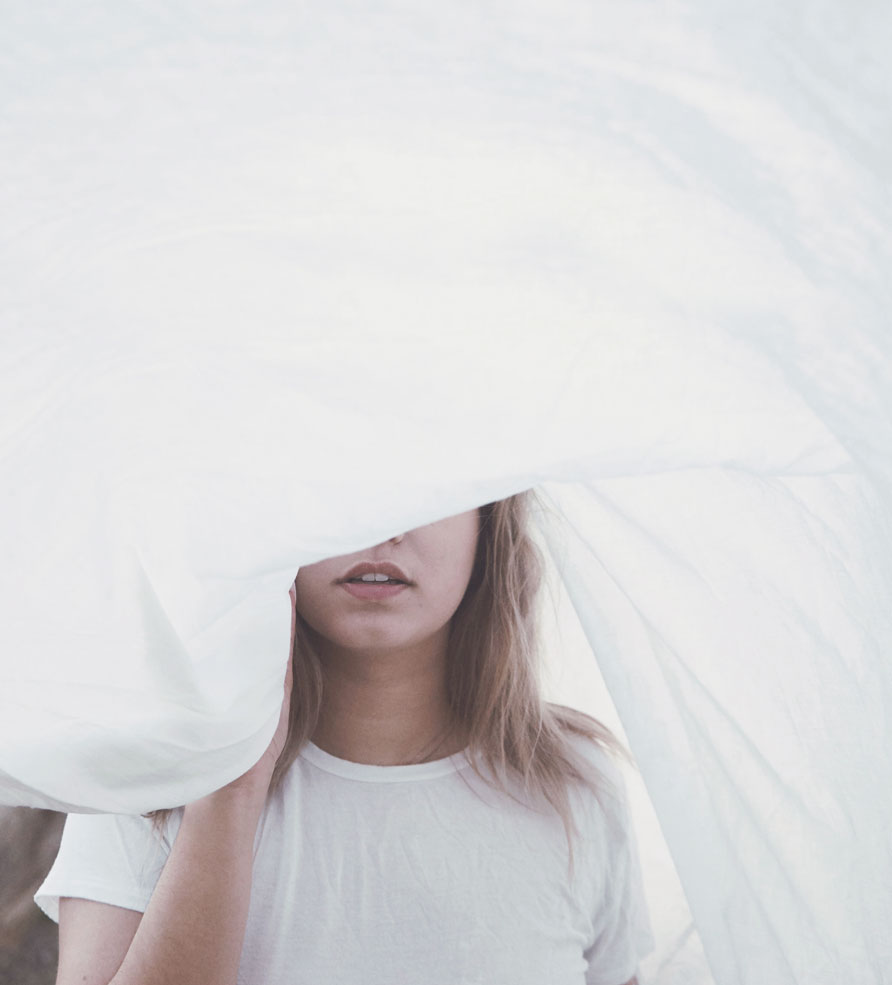
“All artists, whether they know it or not create from a place of inner stillness, a place of no mind.”
– Eckhart Tolle
Stillness Speaks
STILLNESS SEEKER PROMPT:
- Choose a spot in your home or garden to visit each day at approximately the same time and just sit, eyes closed, heart open. Breathe deeply and listen for at least 10 minutes. Notice how you feel afterward.
WORD OF THE MONTH
Stillness
Silence, quiet, an absence of noise and movement.

“In the midst of movement and chaos, keep stillness inside you.”
– Deepak Chopra
Ahhh…sounds lovely doesn’t it? I’m afraid it has become a rare element in our day to day right? And although this definition is accurate it does not describe the power that lies within stillness. It does not describe that stillness is a way of being. A way of embodying an inherent level of peace that resides within us.
This powerful word in practice is the key to unlocking a deeper sense of love, peace and creativity within you.
“Stillness is what aims the archer’s arrow. It inspires new ideas. It sharpens perspective and illuminates connections.”
–
Light Sourcing Meditation
by Rebecca Campbell
In the midst of our crazy lives and hectic circumstances it can be incredibly powerful to visualize a beautiful white light that nourishes us and brings us back to center. This loving mediation did just that for me. Pick a quiet time when you will not be disturbed for about 10 mins to try this one out. I hope you enjoy it.
Light Sourcing Meditation
Embodying Stillness
Let’s explore what stillness feels like and looks like for you. There is no wrong answer. Let’s spend a few minutes journaling about this concept.
Take at least 10 minutes of meditation before you begin to write. Set an intention that you are going to be open to this writing session and that you welcome all loving wisdom.
In your journal or sketchbook write down these questions. Take a moment to reflect upon them and then let your writing flow…
- How does becoming still make you feel?
- If you could describe a landscape or scene that brings you peace what does it look like? After you write about this place, close your eyes and see it in your imagination. Can you draw or paint this scene in your journal?
- When was the last time you felt an inner stillness? What were you doing? Meditating? Painting? Working in your garden?
- How could you create a ritual in your life that brings you moments of stillness? Could it be sitting quietly with a cup of tea? Meditating? Drawing intuitively for 10 minutes?
Consider this quote from our monthly reading, Stillness Speaks by Eckhart Tolle :
“I am not my thoughts, emotions, sense perceptions, and experiences. I am not the content of my life. I am Life. I am the space in which all things happen. I am consciousness. I am the Now. I Am.”
– Eckhart Tolle
This is a beautiful entry point to stillness. Accepting this deeply will give you a sense of stillness and peace almost immediately. It allows all the unnecessary burden we carry to fall away and we can embrace the divine beauty of our being. I highly recommend reading this aloud and noticing how your energy shifts. You may sense some resistance but say it again. Breath deeply and trust that a part of you, a deeply sacred part of you will acknowledge the truth in this.
STILLNESS SEEKER PROMPT:
- Go out into nature and find a safe and peaceful place to sit. Look around you. What do you see? What do you hear? What do you smell? Access your senses and ground yourself in the present moment. Breath and be grateful.
Embodying Stillness
Monthly Affirmation
Each month we will have a positive affirmation. I recommend you print out this affirmation and put it in your sketchbook or somewhere in your studio. Recite the affirmation out loud each time you show up to create. Saying words aloud is powerful and can begin to re-write some of our own limiting beliefs or calm our fears. Try it now…
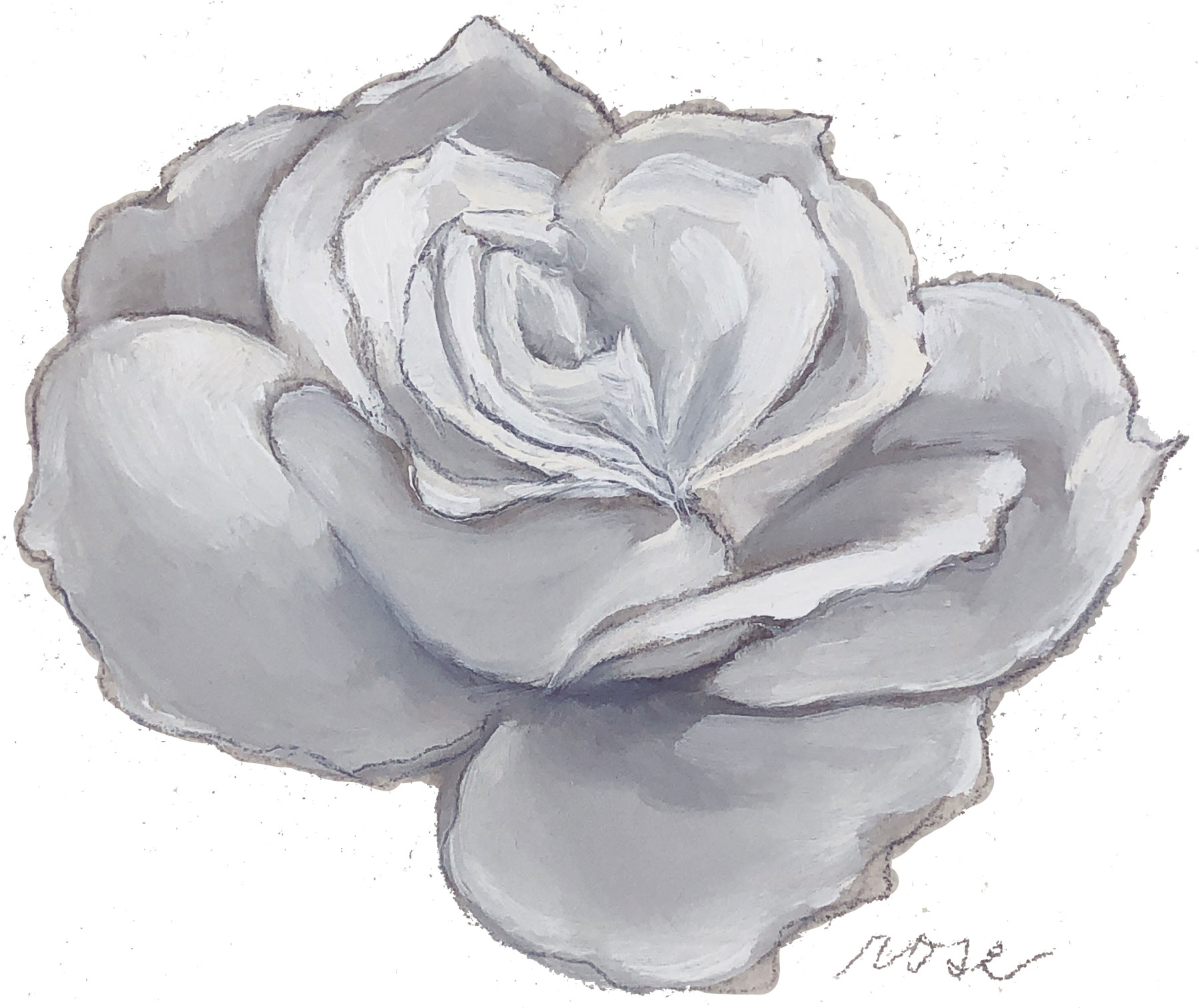
Color Palette of the Month
With stillness and peace enveloping this issue, I thought it only fitting that we let the soft shades of white wrap around us. Soothing our souls and reminding us of tranquility, light, possibility and simplicity. Working in the many shades of white, cream, pearl, alabaster, egg shell, snow, bone ivory and more will introduce us to subtle shifts in hue. Of course, to find deeper values while working with these colors we will dip into soft grays, taupes and whisper blues.-
“White… is not a mere absence of colour; it is a shining and affirmative thing, as fierce as red, as definite as black… God paints in many colours; but He never paints so gorgeously, as when He paints in white.””
– Gilbert K. Chesterton

STILLNESS SEEKER PROMPT:
- Gather or purchase a beautiful bouquet of white flowers, put them somewhere in your home and let them remind you to breathe and feel peace within you.
White Space
Composition and the elements of design
I have always been drawn to artwork with limited palettes and I find myself inspired by their simple grace and peaceful appearance. I also began to notice that when color is stripped away, composition becomes more important and vital to the success of the piece.
Many of you may know that I’m a bit of a composition freak. I absolutely loved analyzing works of Art during my days at Art School! I found it satisfying and revealing to understand the “WHY” behind what made a piece visually coherent. Of course, Art will forever be subjective but the basic principles of design can be seen in almost all well renowned works.
I believe it is important to know why we choose certain design choices over others….why did I put my horizon line there or add that contrasting square of black? Of course, it’s important to know the “What’s” too! What does this piece need to balance it? What must be taken away to create unity? These are the questions that we need to know how to answer. We need to be able to step back and scrutinize, deconstruct and evaluate our compositions.
Ready for a little Composition 101! I’ve created audio files so you can listen to me analyze these beautiful works of art. Enjoy!
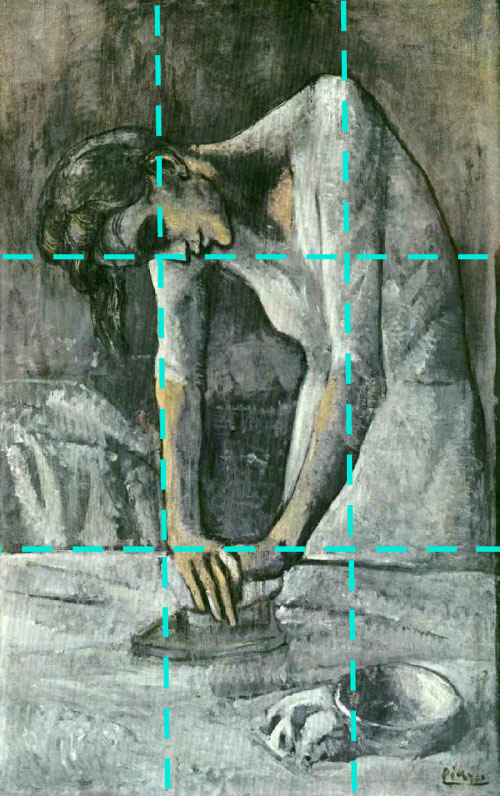
COMPOSITION 101
Okay, let’s examine the basic Principles of DESIGN!
The principles of design include: balance, proportion, emphasis, variety, movement, rhythm, and harmony. They are used to organize the basic elements of art (line, shape, form, value, color, space, and texture), and they are sometimes also referred to as principles of organization.
BUT – Before we examine these principles, let me first briefly talk about the Rule of Thirds. You may have heard this term used before. It is often used in photography but its rules apply to artmaking in general. It is defined as this:
“The rule of thirds is a “rule of thumb” or guideline which applies to the process of composing visual images such as designs, films, paintings, and photographs. The guideline proposes that an image should be imagined as divided into nine equal parts by two equally spaced horizontal lines and two equally spaced vertical lines, and that important compositional elements should be placed along these lines or their intersections. Proponents of the technique claim that aligning a subject with these points creates more tension, energy and interest in the composition than simply centering the subject.”
Let’s see the Rule of thirds in action:
This piece by Picasso, entitled Woman with an Iron, is a perfect example of the power of the rule of thirds. Listen as I discuss why this works here…
Rule of Thirds
Alright, now that we got the Rule of Thirds down, let’s look at some more Artwork to explore the Principles of Design.
**Oh and remember the Rule of Odds too! Odd numbers are more pleasing to the eye in general. So think three flowers over two or nine circles over eight. Remember to consider this when adding elements to your work. **
Pinciples of Design
Balance • Proportion • Emphasis • Variety • Movement • Rhythm • Harmony
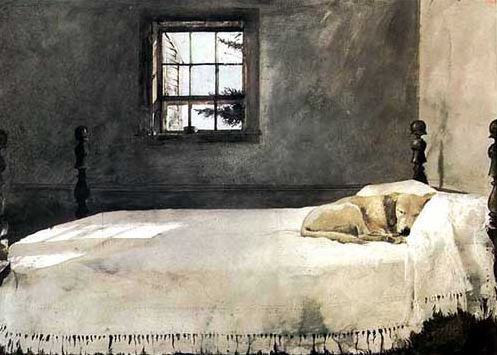
BALANCE
Balance is when there is a sense of stability achieved through implied weight of an object. There are three different types of balance that are used when making an artwork: symmetrical, asymmetrical, and radial. Symmetrical balance is when one image is mirrored on the other side to repeat itself; this is a very simple way to create balance. Asymmetrical balance is when you use different types of elements to create a visual balance. For example, with asymmetrical balance you might use strong color in one area and instead of repeating that same image you would use a large space to create balance. Radial balance is the last way to create balance in an artwork and it is where art elements are distributed around a central point in all directions.
Balance
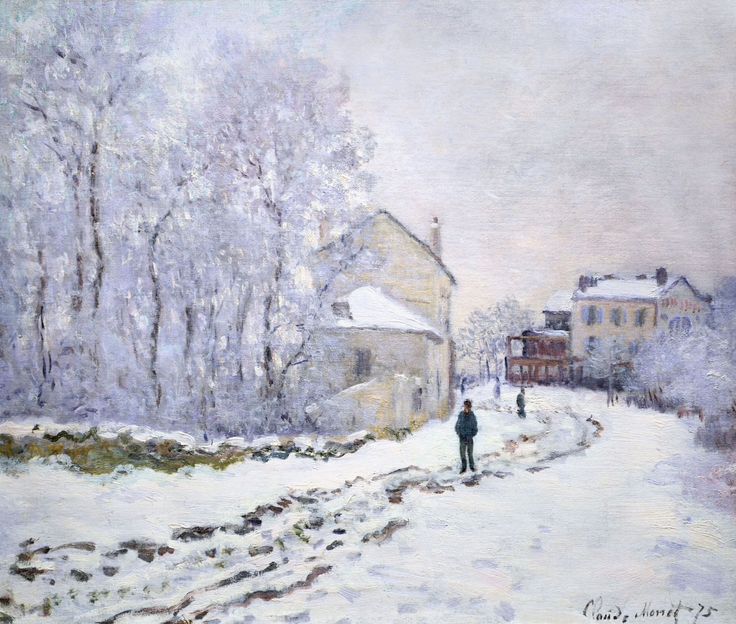
PROPORTION
Proportion is the ratio of one art element to another. It is important to keep in mind the comparative relationship between different elements that make up the whole composition so that the scale of your artwork always makes visual sense.
Proportion
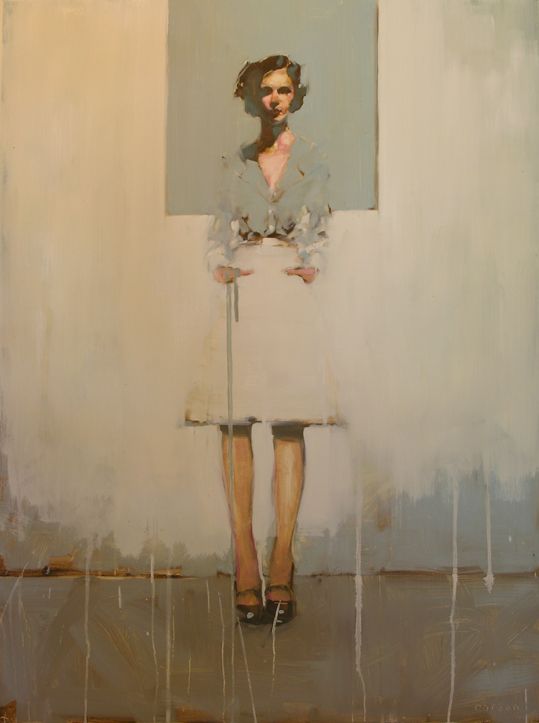
EMPHASIS
Emphasis is when one element of an artwork stands out more than another this is also called a focal point. This creates a sense of importance and is usually intentionally used to communicate a message or feeling. The focal point helps the viewer understand your focus and where to look first.
Emphasis
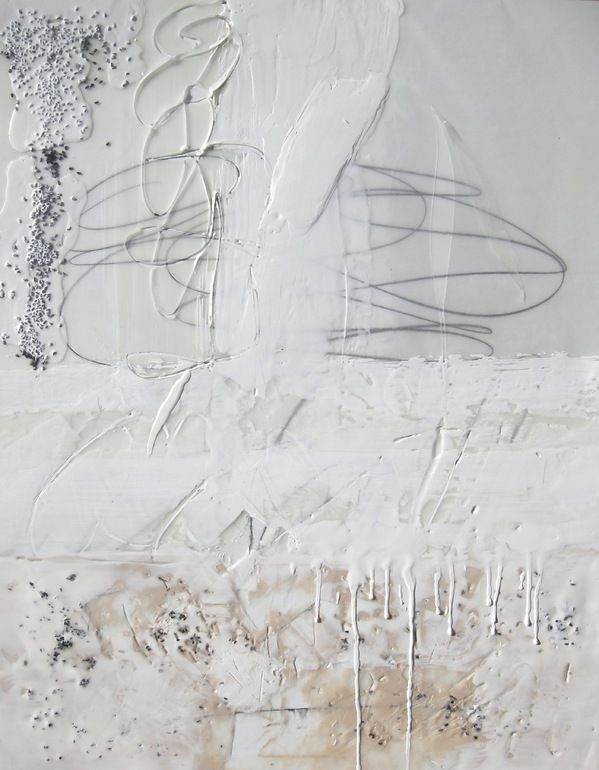
VARIETY
Variety is the counterweight to harmony and is another principle used to create visual interest by slightly changing or using different elements together in a composition. It can be created with contrast, change, elaboration, or diversifying elements. With variety it is important to always be thinking about how the elements are working together so that you still have harmony and unity within a composition.
Variety
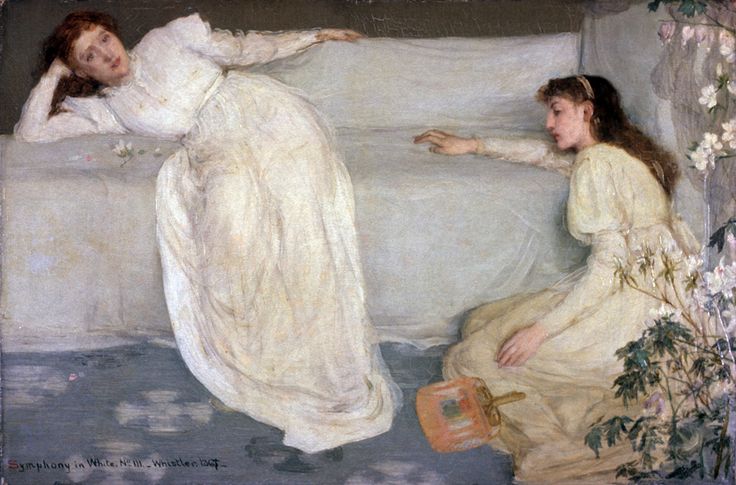
MOVEMENT
Movement is the visual flow of your artwork. It’s the path that you intend your viewer’s eye to follow. You can create this by purposefully placing art elements in a way that creates a path for the eye to follow.
Movement
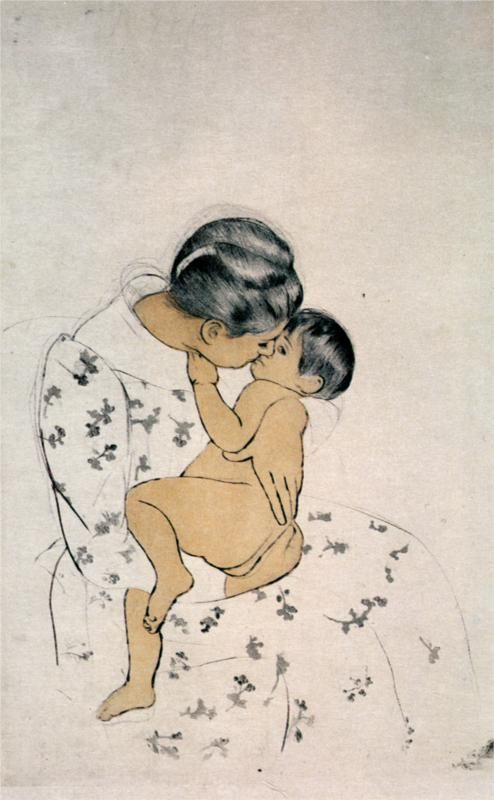
RHYTHM
Rhythm (also known as repetition or pattern) is consistency with colors and lines or shapes. Putting a black circle at the bottom left and top right, for example will cause the eye to move from one circle to the other. It is indicating movement by the repetition of elements. Rhythm makes an artwork seem active.
Rythm
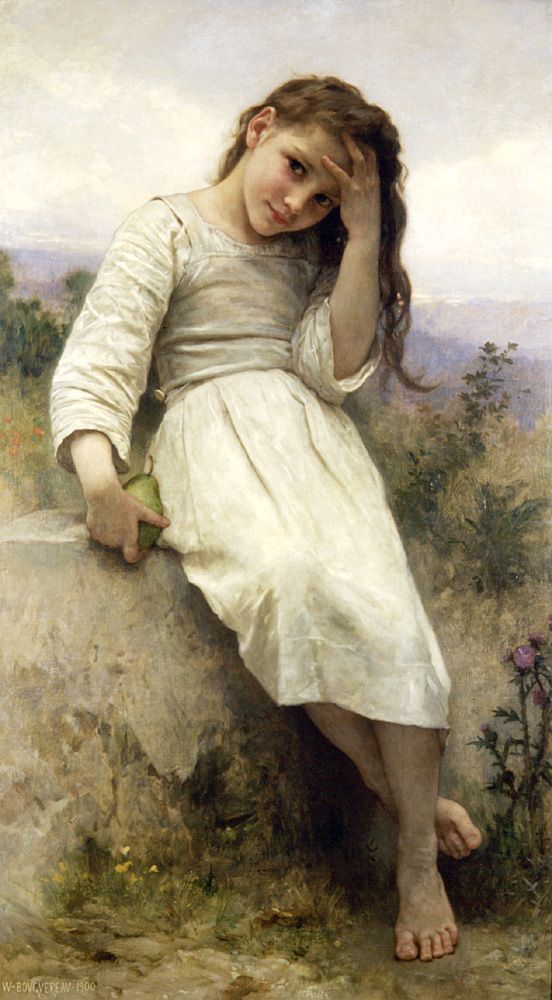
HARMONY
Unity or harmony is the quality of wholeness or oneness that is achieved through the effective use of the elements and principles of art. It is the arrangement of elements and principles to create a feeling of completeness.
Harmony
“White Space is where the world and all distraction falls away. Where the voice of the Divine can be heard. Where the Truth of who you are is found. Where miracles happen.”
– Valerie Rickel
White Space
MASTER ARTIST GUIDE
Giovanni Lorenzo Bernini
Since we are studying shades of white and inviting in more stillness to our practice, I thought it only fitting to explore some gorgeous sculptures. One of the most loved sculptors of all time is Giovanni Lorenzo Bernini.
There is an unearthly beauty and grace in his wondrous sculptures. He captures a moment frozen in time and gazing upon his work, you can almost imagine these pieces of cold marble coming to life, taking a breath and stepping off their pedestals.
One of the most exquisite statues I have ever seen was Bernini’s – “Apollo and Daphne.” It took my breath away and brought tears to my eyes. You can feel the emotion and the movement in it! You can hardly believe it is made from stone!

ABOUT BERNINI
Giovanni (Gian) Lorenzo Bernini was born in 1598, the sixth of thirteen children of Angelica Galante and Pietro Bernini. Bernini’s childhood was spent in Naples and he began sculpting from an early age working closely with his father. Bernini was a deeply religious Catholic and created his first work at the age of eight. His father encouraged his skill, recognizing early the prodigy he would become.
This lifelong dedication to practice would lead to Bernini’s development of his own style which would go on to greatly contribute to the Baroque movement.
Bernini’s reputation for artistic mastery flourished in the city of Rome, which led to his employment by a succession of six Popes, a role held by Michelangelo before him. This established him within a solid career that would continue for life. From 1618 to 1625, Bernini worked prolifically, creating masterpieces such as The Rape of Proserpina, David and Apollo and Daphne.
He had a long, prosperous career working as both an artist and architect. He died in 1680 at the age of eighty one and was buried alongside his parents in the Basilica di Santa Maria Maggiore.
“The white marble has to assume the likeness of a person, it has to have color, spirit and life.”
– Bernini
Please enjoy this slideshow of some of Bernini’s most beautiful sculptures and see some of his drawings too!
Here is a little video about this very famous sculpture. If you are ever in Rome, I highly recommend visiting it.
Master Artist Guide - Bernini
Sketchbook Explorations
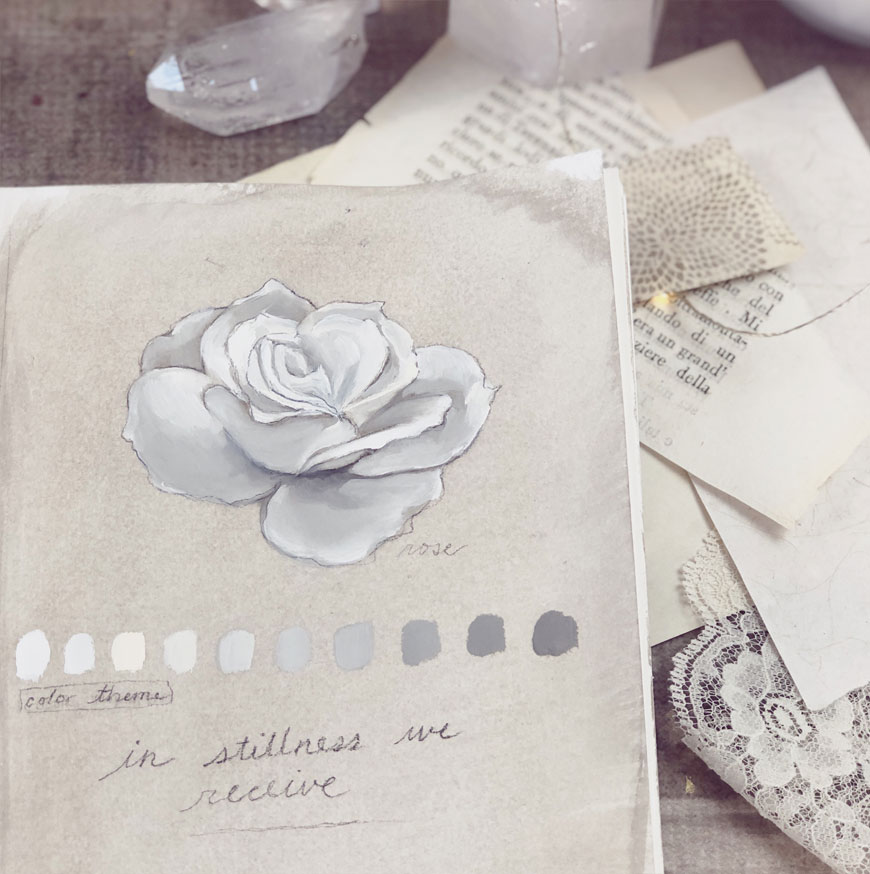
Before we begin our explorations, I wanted to provide a cohesive theme for us to focus on. This will help unify our explorations and provides us with a simple place to start when approaching a VERY blank sketchbook.
Our sketchbook theme this month is shades of white as you may have guessed. Explore the subtle layers and tones that fall under this color (or lack of color) and experiment with delicate shifts of value, harmony and light.
Please remember, our explorations in our sketchbook are really just access points to get you into the flow. However, they can also be seeds for new ideas, concepts and themes in your art. Some of them will be more about writing and others more about drawing and painting. You will see below three prompts and exercises explained and photographed from my own sketchbook. You are welcome to expand upon, invent and experiment with your own concepts too. Use our color palette if you want to. You will see I stay in that theme for my explorations. These may feel silly at first but let your inner artist play.
EXPLORATION 1
White on White Collage
Gather together pieces of different “white” papers, these could be vintage pages from an old book, a page from a notebook, an old receit, a piece of white washi tape, some white tissue paper….etc. Collage them noticing all the shades of white they comprise of. Feel free to add white paints, pencil, pen or other media to enhance this. How can you make the composition interesting? Since there is a lack of color, can you emphasize texture? Remember the elements of design we discussed earlier. This is a great way to exercise your compositional muscle so feel free to do a few of these!
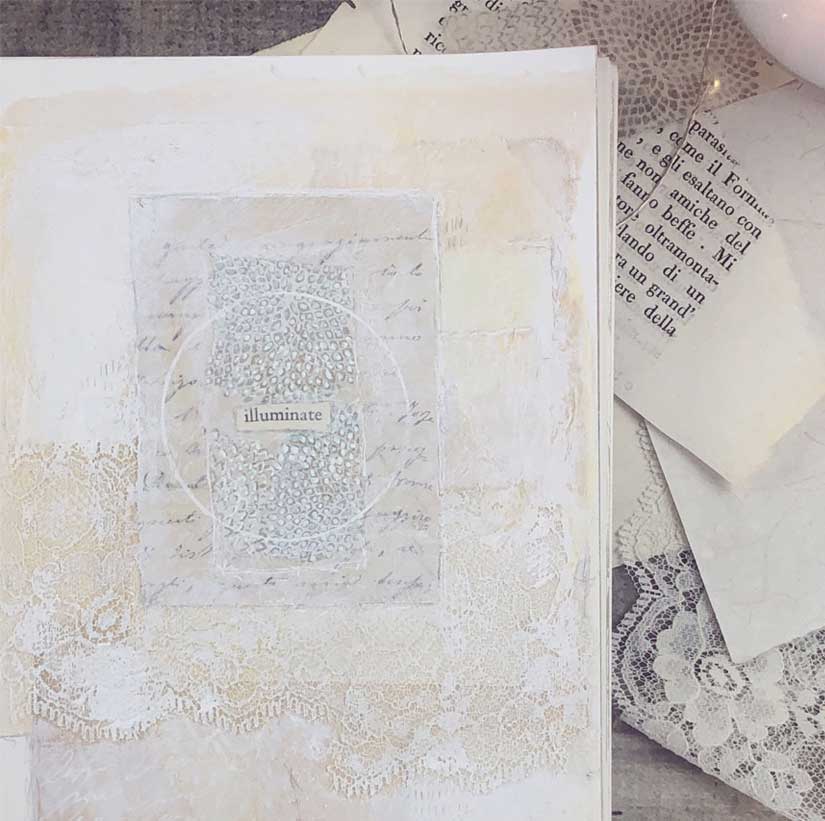
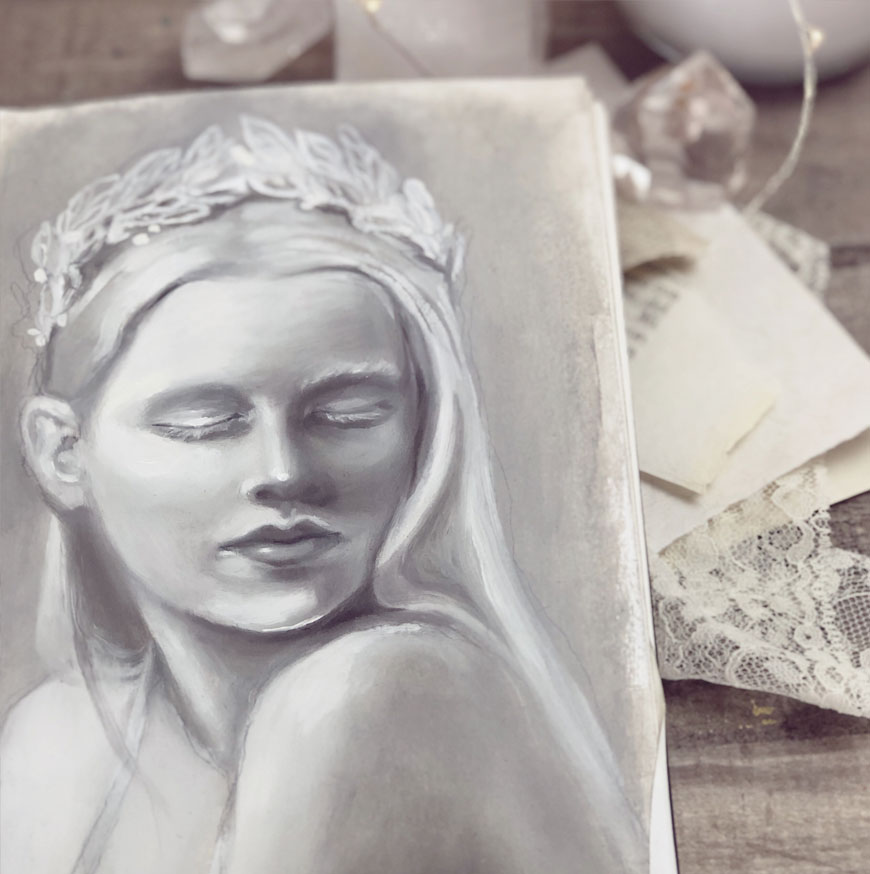
EXPLORATION 2
Pale Portrait
Finding inspiration from my Pale Portraits Pinterest* board or from your own inspiration, create a high key portrait – which means a portrait with subtle contrast. I will most likely work with soft grays, creams and white for this one. I am using this gorgeous image (with permission) via Kate Metamorphose from her beautiful Etsy shop!
PLEASE NOTE: If you paint something that is copyrighted from Pinterest please remember to respect that and do not sell the painting. It’s fine to just create for you. : )
EXPLORATION 3
Shades of White Landscape
Create a small landscape in your sketchbook, it could be a master study from our Pinterest board – “Shades of White” or it could be something from your own intuition or inspiration. Explore how to bring harmony and subtle contrast to create something interesting. Consider warm and cool shades of white too.
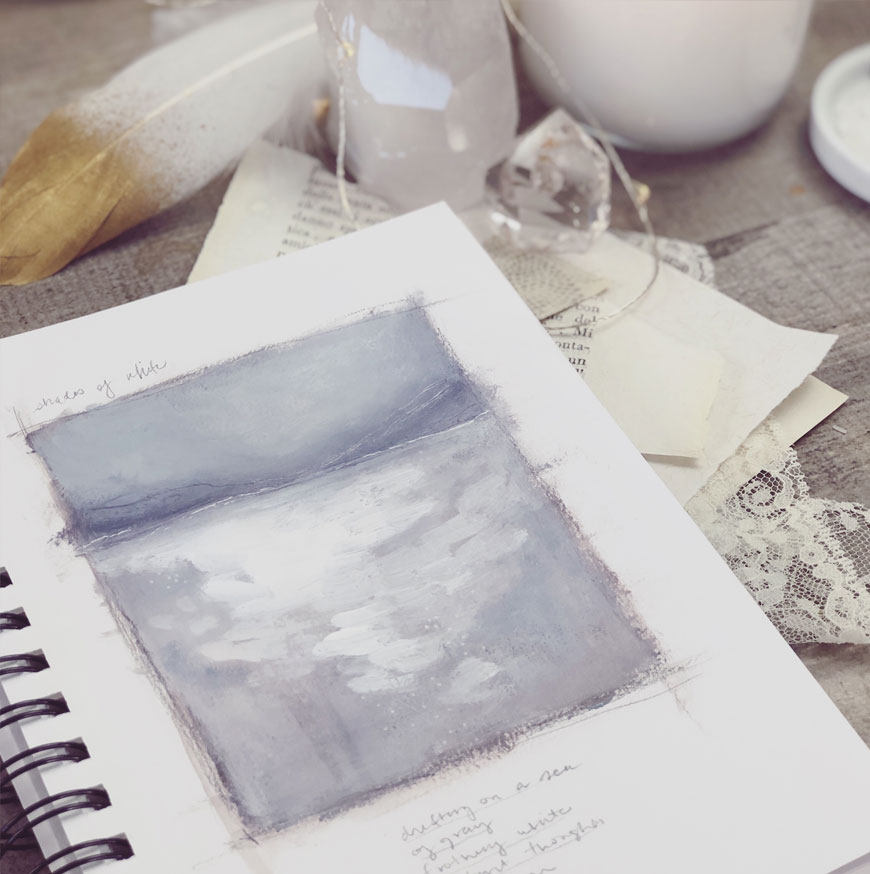
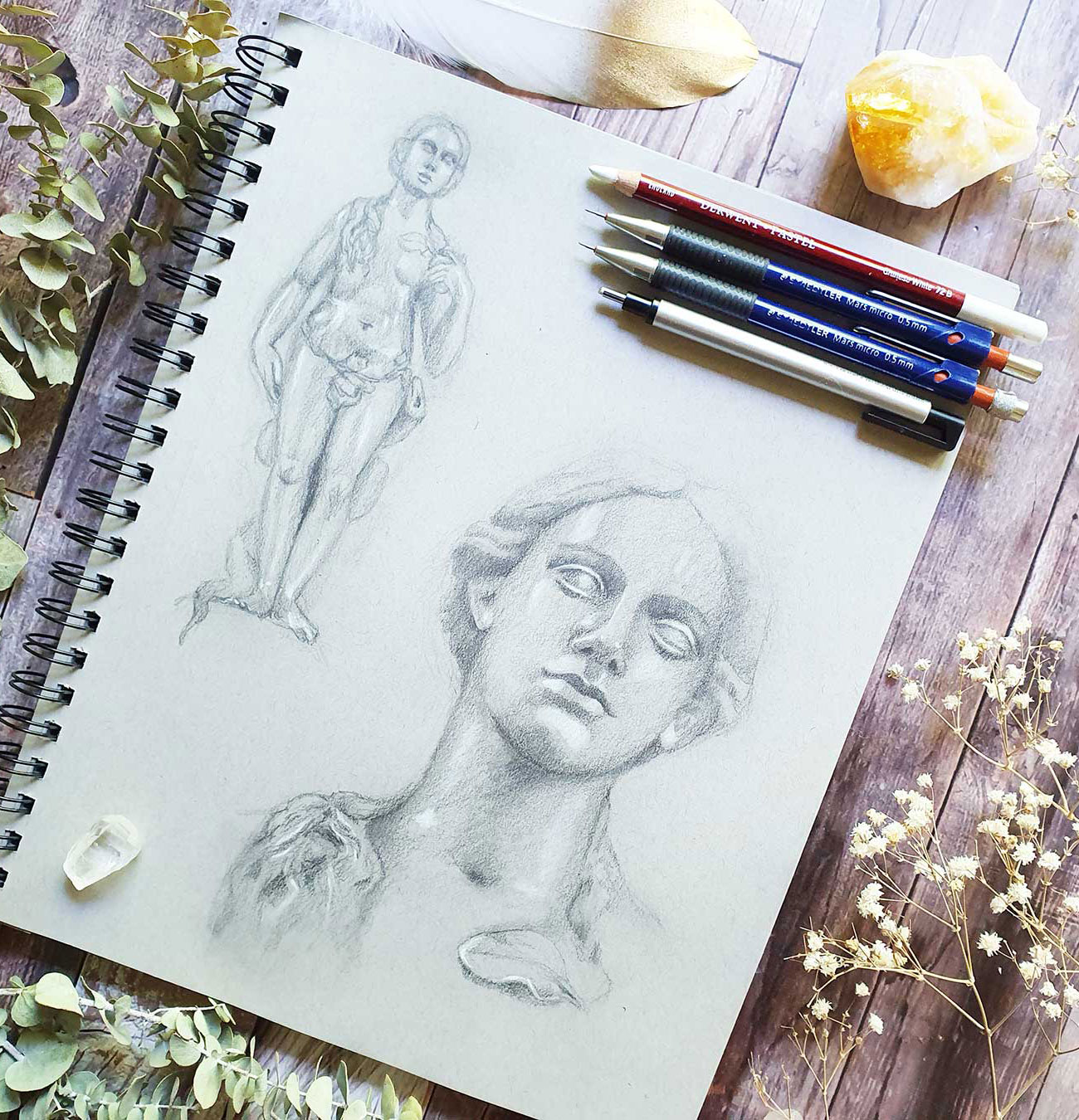
MONLTHLY ART PROJECT
Beauty in Stillness
She’s a master of the pencil, a dear friend and a fellow teacher – this month, Natalie Eslick brings us a beautiful study of a marble statue of Eve. We both saw this statue in person in Orvieto this past summer and she’s truly a beauty! Of course, a study of a statue falls beautifully into our theme of shades of white and stillness. ( Yes, I planned that! ; ) lol.
Enjoy watching Natalie create!
STUDIOWORKS PODCAST
issue eleven
You can also listen to this month’s issue of the Studioworks journal. I find I love listening to books, podcasts and music while I draw, paint or go on a long walk. Enjoy.
Studioworks : issue eleven

inspiration: curated
One of my favorite things to do is to curate inspiration. From Pinterest boards to books, resources, playlists and more – I love to share anything that might facilitate learning, expansion, and sparks of curiosity! Being an artist, we naturally crave these things so here are some of this month’s picks from me to you.
BOOKS FOR CULTIVATING STILLNESS
MUSIC PLAYLIST
I had so much fun curating this list. I hope you enjoy!!
INSIGHT TIMER APP
This app, my friends, has been a GAME CHANGER in my meditation practice. It is a powerhouse of wonderful audio courses, podcasts and of course meditations! It keeps track of your meditation practice and has inspired me to be accountable to this vital ritual in my life. Highly recommended!
INSTAGRAM MUSES
These feeds capture our mood of the month with beautiful soothing art…
PINTEREST BOARDS
FAVORITE SUPPLIES THIS MONTH
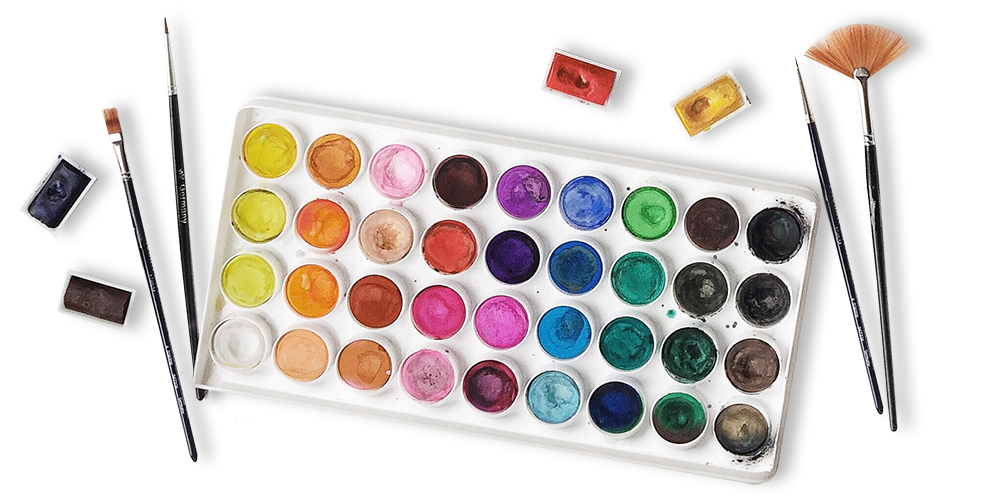
Strathmore 400 Series Toned Gray 9in x 12in 80lb
CLASSES TO TRY
These classes carry much of the same feeling of magic and exploration. I highly recommend checking them out if you haven’t already. Enjoy!

© 2019 IVYNEWPORT, LLC ALL RIGHTS RESERVED.

